|
THE ALHAMBRA
|
TAKEO KAMIYA
|
THE ALHAMBRA
|
TAKEO KAMIYA
|
After the downfall of the Spanish Umayyad Dynasty in the 11th century, Islamic strength in the Iberian Peninsula gradually declined and Christian Reconquest proceeded. The last Islamic kingdom was the Nasrid Dynasty, which is also referred to as the Kingdom of Granada taking the name of its capital. Despite being a small kingdom it kept its independency by dexterous diplomatic capability ranking with Christian countries and its aid to the arts and learning encouraged the last Islamic culture in Europe to bloom splendidly.
 The Citadel looking down the city of Granada On Albaycin hill in Granada a large citadel had been constructed around the 10th century, which was referred to as eQalfat al-Hamraf (the Red Fort) , which got its name from the color of the red soil of the hill and bricks burnt of that soil. (Later in Delhi and Agra, India, the palace-fortresses would also be referred to as the eRed Fortf due to their main material, red sandstone.) The palace called Alhambra corrupted from al-Hamra was constructed at the northern part of the citadel in the 13th ~ 14th centuries. It has become a true gem of palace architecture by reiterated refinements and sophistications.
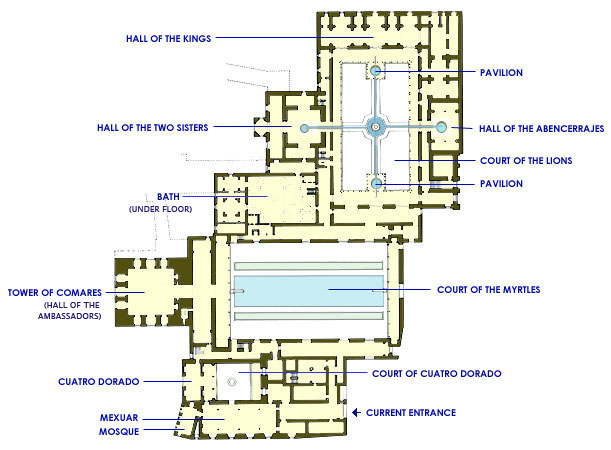
A ecitadelf is a town surrounded with defense walls. Though there was an inner city east of the palaces in the past, it has disappeared without leaving any trace. There is a military fortress (Alcazaba) that protected the city and palaces, strengthening defense on the side fronting the Darro River. Since all of them along with the walls surrounding the whole site were made of reddish-colored bricks and stones persistently in the pursuit of its function and strength, it does not look like a world famous graceful palaces, viewed through outsider's eyes. However, when one tread inside of the palaces and courtyards (Patios) surrounded by those walls, finding another world unfolding sequentially, one may be deeply fascinated with their elegant appearance and atmosphere on a human scale. Superb interior spaces and orderly courtyards are enclosed by a modest (occasionally humble) external appearance; thatfs just the characteristic of Islamic architecture. There is no such palace architecture in the world as the Alhambra; that is far from authoritarianism and grandiosity, devoting itself to the world of beauty based on the small-scaled sensible experiences.
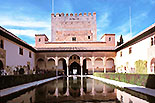  Court of the Myrtles and a stucco decoration on its wall The palace rooms are arranged around the two courtyards: one is the eCourt of the Myrtlesf (Patio de Comares) built in the first half of the 14th century, the area for the purpose of kingsf public audience. The other is the eCourt of the Lionsf (Patio de los Leones) built in the latter half of the 14th century, the private area, that is the seraglio (Harem) where general vassals could not enter. So the two are still separated palaces without holding a common axis and even now tourists have to move from one to another, winding their way from around the edge. As a garden (Bagh), more characteristic one is the Court of the Lions, where the water basin sustained by twelve sculptures of lion sends up a jet. It is encircled with cloisters, from which two pavilions project to the patio, and the channels flow out from the cardinal point rooms to come together to the central fountain, so as to divide the rectangular garden into four-quarters. That is exactly the equadripartite gardenf (Chahar Bagh) constituting the basic principle of Islamic gardens.
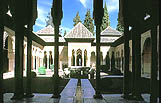  Court of the Lions and its Cloisters For the cloisters, marble columns stand in line rhythmically, looking like a forest when looked upon from a pavilion. Lower parts of the walls are embellished with faience tiles in geometric pattern; the upper parts and ceilings are ornamented with carved stucco in foliage pattern, which glitters reflecting sunlight. Since Europeans referred to Muslims in Northwest Africa and Spain as Moors, the exuberant arts like these in the districts were also called eMoorish Arts.f In former times, this quadripartite garden enclosed with cloisters was a vast flowerbed filled with cheerful flowers of each season. The whole setting and arrangement like this is just a realization of the Heavenly Paradise on the earth, which is described in the "Qur'an" (Koran) and has been yearned by all Muslims.
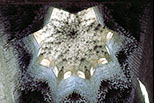 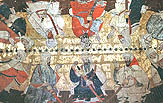 Ceilings of the Hall of the Abencerrajes and the Hall of the Kings The Nasrids who had created an unequaled elegant aesthetics in the matured stage of Islam was overthrown by Reconquest and retreated to Morocco in 1492, delivering their fort and palaces to Christians. In that year Islamic power came to an end in Europe, Christopher Columbus departed on a voyage, encountering a new land confusing it with India. (In "Architecture of Islam" 2006) > E-mail to: kamiya@t.email.ne.jp
|